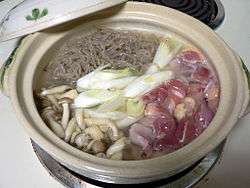Shirataki noodles
Shirataki (白滝, often written with the hiragana しらたき) are translucent, gelatinous traditional Japanese noodles made from the konjac yam (devil's tongue yam or elephant yam).[1] The word "shirataki" means white waterfall, referring to the appearance of these noodles. Largely composed of water and glucomannan, a water-soluble dietary fiber, they are very low in digestible carbohydrates and calories, and have little flavor of their own.[2][3][4]
 Shirataki noodles (top) and other ingredients in a donabe | |
| Type | Japanese noodles |
|---|---|
| Place of origin | Japan |
| Main ingredients | Noodles (konjac yam) |
Shirataki noodles come in dry and soft "wet" forms in Asian markets and some supermarkets. When purchased wet, they are packaged in liquid. They normally have a shelf life of up to one year. Some brands require rinsing or parboiling, as the water in the packaging has an odor some find unpleasant.[5][6][7]
The noodles can also be drained and dry-roasted, which diminishes bitterness and gives the noodles a more pasta-like consistency. Dry-roasted noodles can be served in soup stock or a sauce.[8]
Sources
The glucomannan noodles come from the root of an Asian plant called konjac (full name Amorphophallus konjac). It has been nicknamed the elephant yam, and also called konjaku, konnyaku, or the konnyaku potato.[9]
Other names
Shirataki also goes by the names "ito konnyaku", yam noodles, and devil's tongue noodles.[10]
Ito konnyaku and shirataki
There used to be a difference in manufacturing methods. Producers in the Kansai region of Japan prepared ito konnyaku by cutting konnyaku jelly into threads, while producers in the Kantō region made shirataki by extruding konnyaku sol through small holes into a hot, concentrated lime solution.[11] Modern producers make both types using the latter method. Ito konnyaku is generally thicker than shirataki, with a square cross section and a darker color. It is preferred in the Kansai region.
References
- Hui, Yiu. "Handbook of food science, technology, and engineering, Volume 4." CRC Press: 2006. p. 157-11.
- "Shirataki Noodle Recipes: The No-Carb Pasta". September 28, 2012. Retrieved August 28, 2016.
- "Konjac Foods - Pure Fiber Zero Calories Pasta". www.konjacfoods.com.
- "Why My Fridge Is Never Without Shirataki Noodles (and Yours Shouldn't be Either)". February 18, 2015. Retrieved August 28, 2016.
- "Shirataki Noodles: The Zero-Calorie 'Miracle' Noodles". Healthline. 6 December 2018. Retrieved 10 April 2019.
- "Shirataki Noodles Are Hideous". HuffPost. 15 October 2014. Retrieved 10 April 2019.
- "Wake up and smell the konjac". Slim Rice. 3 March 2015. Retrieved 10 April 2019.
- "How To Cook". Miracle Noodle.
- About.com Shirataki Site About.com's information about shirataki noodles, how they are made and where to get them.
- Hui, Yiu. "Handbook of food science, technology, and engineering, Volume 4." CRC Press: 2006. p. 157-12.
- (in Japanese) 「糸こんにゃく」と「しらたき」論争 Archived 2011-02-27 at the Wayback Machine, Tokyo Gas